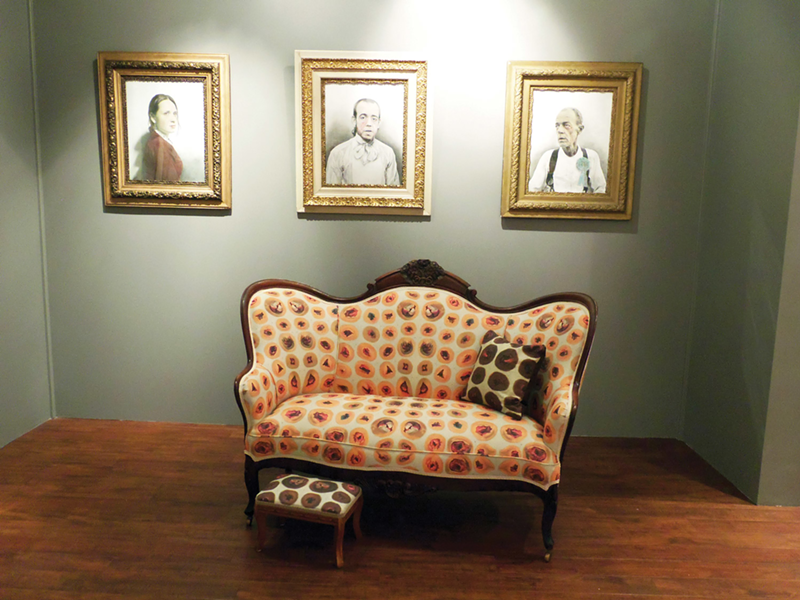The Lloyd Library and Museum may not be on your accustomed arts radar but its extraordinary current exhibition could put it there.
Wounded Home reflects the ghastly physical toll war has on its participants as well as its psychological toll on them and their families. Conceived in response to the Civil War sesquicentennial — but with implications for all wars — the exhibition has been nearly two years in the making and, for at least some of the seven artists involved, is the development of ideas that first surfaced long before.
The library, a historical research center home to a collection of botanical, medical, pharmaceutical and scientific books and periodicals, proved to be a resource the Wounded Home artists found rich in many ways. “It was a new way of working,” says Columbus artist Jenny Fine, whose sensitive portraits line two walls of the exhibition space. Fine says, “In the end, our work was overlapping in interesting ways.” The exhibit takes place in a parlor designed and built by artists Celene and Jerrett Hawkins, installed right in the museum.
Exhibits and Education Coordinator for the library, Anna Heran, first contacted artist Kate Kern about the show in September 2011. “Wounded Home is probably the most elaborate group exhibition I have been involved in as an organizer/curator,” Kern said by email. The group met periodically as the works took shape and all used the extensive resources of the library to develop their individual contributions. An accompanying exhibition of the books they used for research with artists’ comments deepens understanding of Wounded Home.
Mary Jo Boyle, whose wallpaper fills one side of the parlor and is also seen in the entryway, says, “I often utilize research in my work. The library is a dense and wonderful collection.” Boyle, like Fine, a Columbus-based artist (all others in the exhibition are from Cincinnati), adapted such images as a tin-type of army tents, a baby with a gun, microscopic bacteria and a listing of diseases in old-fashioned handwriting to produce meticulously printed wallpaper with terrible themes.
When the idea of using a Victorian era parlor as a setting emerged, artist Saad Ghosn felt his contributions would reflect the battlefield too directly to be there, so those form the entranceway to the parlor. His “Price of a Civil War” consists of lines of sticks, 620 sticks in all, both white and black to represent both races, each tipped with red signifying the bloody deaths of a thousand soldiers.
“I also wanted to use religious iconography,” Ghosn says of his two posters, one reflecting da Vinci’s “The Last Supper” and the other, Jesus’ crucifixion. Boyle’s wallpaper of lines upon lines of army tents faces Ghosn’s work.
The horrors of war seem momentarily at bay with Alice Pixley Young’s fragile, lovely kiln cast glass lace collars, mounted on the entrance wall to the parlor, but the collars’ graying parts suggest hard times and their title, “Absence,” is telling. Commenting on the project, Young says, “There were no hard and fast rules. Things grew organically.” Her video, “This Distance,” in a nook off the parlor, reflects the two sides of the Ohio River, departure and arrival points for escaping slaves, but is hard to fathom without the guide of the artist’s explanation.
Two innocuous domestic fixtures dominate the parlor. Kern’s settee with its visually pleasing but ultimately distressing pattern of bullet wound images is one of them. The other, Deborah Brod’s “Wounded Table/Cloth,” has a roughly bandaged broken table leg and an uneasy, heavily sketched on, multi-piece cloth of semi-transparent paper. An airy centerpiece made up of a thorny branch decorated with curls of slim rawhide strips (whips?) rises perhaps four feet. Brod and Kern collaborated on “Feeding the Flame,” moving digital images projected in the parlor’s “fireplace.”
Above all this is Celine Hawkins’ chandelier, a gorgeous fixture until its iconography registers. Hawkins says she found the show an opportunity to be “more topically direct.” Cotton is her theme here — cotton balls hide the light bulbs, handsome figures on the shaft are in fact chained and plant pests and diseases can also be seen.
This complex, idea-filled exhibition disturbs the mind while it pleases the eye. Brod, reflecting the latter element, says, “It’s like a pot luck dinner where all the dishes serendipitously go together.” Heran says of the show, “It was risk-taking for us, but the response is very positive.”
WOUNDED HOME runs through Jan. 20 at Lloyd Library and Museum, 917 Plum St., Downtown. More information at lloydlibrary.org.


